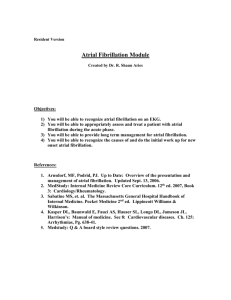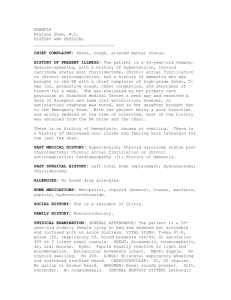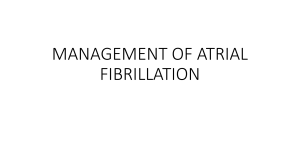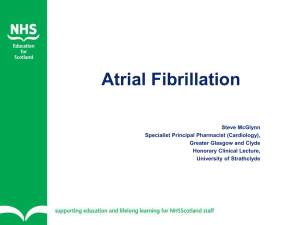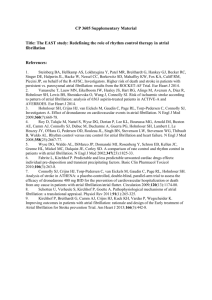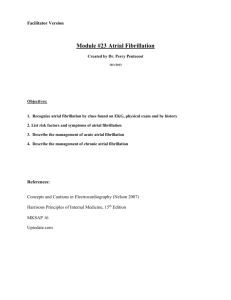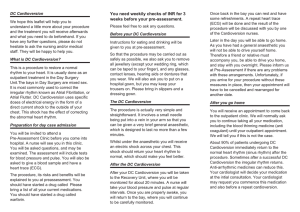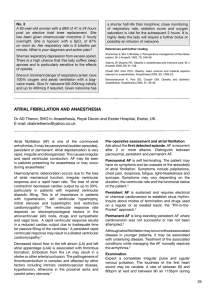Atrial Fibrillation Service
advertisement
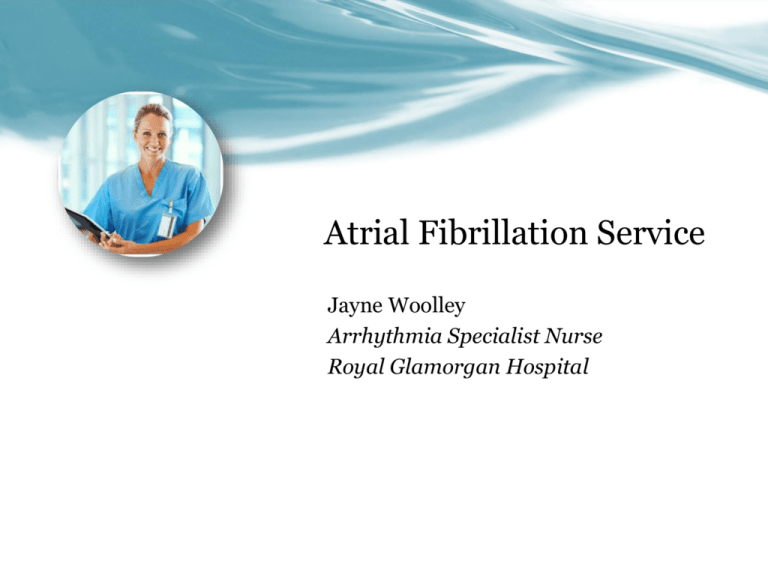
Atrial Fibrillation Service Jayne Woolley Arrhythmia Specialist Nurse Royal Glamorgan Hospital Atrial Fibrillation Service • In-patient referrals for New onset/Incidental finding AF – Advice and support to medical team – Provision of patient information and counselling – Weekly AF MDT meeting – Follow-up clinics – Dronedarone – monthly monitoring – Anticoagulation/NOAC counselling initiation Atrial fibrillation Service • Both Rate/Rhythm control need : Stroke risk assessment CHADS2 – 0/1 reassess risk CHA2DS2VASc score 1 anticoagulation to be considered 2 anticoagulation recommended Atrial Fibrillation Service • HASBLED score Hypertennsion (systolic > 160mmHG) 1 point Abnormal renal/liver function (chronic dialysis/transplantation, serum creatinine >200mmol/L chronic hepatic disease, bilirubin 2 x upper limit alkaline phosphatase 3 x upper limit 1 point each Stroke 1 point Bleeding 1 point previous bleeding history, anaemia etc Liable INR’s 1 point < 60% in theraputic range, unstable high INRs Elderly > 65yrs of age 1 point Drugs/Alcohol concomitant use of drugs , antiplatelet agents, alcohol abuse 1 point each SCORE OF >3 HIGH RISK Atrial Fibrillation Service • NOAC s for stroke prevention in adults with non-valvular AF with 1 or more risk factors: • Stroke/TIA/Systemic embolism • Symptomatic heart failure (NYHA) class >2 • Left ventricular failure, ejection fraction <40% • Age >75 yrs • Age >65 plus one of the following: •Diabetes mellitus, coronary artery disease or hypertension Dabigatran, Apixaban and Rivaroxaban Pros: Lower intercranial haemorrhage Rapid onset/short half life No monitoring No food restrictions No alcohol restrictions Less drug interactions Cons: No known reversible agent No monitoring Heartburn/bloating/diarrhoea 100% compliance Atrial Fibrillation Service • Elective cardioversion Receive referrals – Arrange anticoagulation and required investigations – Recording weekly INR results (warfarin) – Pre-assessment clinics – If on NOAC declaration is signed by patient – Cardioversion procedure – 1 + 6 month follow-up clinics Atrial Fibrillation Service • Elective cardioversion every 4 weeks 5-6 patients per list 13 currently waiting at least 2 extra lists per year Waiting Times for Cardioversion Min 4 Weeks Max 12 Weeks Longer if subtheraputic INR Atrial Fibrillation Service Cardioversion April 2013-April 2014 88 patients listed 2 extras lists 82 successful - 93% 6 unsuccessful on the day - 7% (rounded up) max 3 shocks delivered, AF in theatre Cancellations and Deferred Patients April 2013 – April 2014 • Cancellations o • 5 – SR on workup/Pre-assessment Deferred o 2 – raised TSH (above 10) o 12 – low INR Atrial Fibrillation Service • Pre/Post cardioversion Weekly INRs 3 weeks before Preferred range 2.5 to 3.0 (reduced risk of stroke at higher level) if INR below 2 in the 3 weeks then they are cancelled Weekly INRs 4 weeks post cardioversion Preferred range 2.5 to 3.0 (reduced risk of stroke at higher level) ESC and NICE state that anticoagulation should continue and not be interrupted for minimum of 4 weeks post cardioversion Thromboembolic complications of direct cardioversion are generally related to inadequate intensity of anticoagulation. The INR at the time of conversion is very important. Anticoagulation is necessary for the conversion of atrial flutter as it is for atrial fibrillation. The INR should be 2.5 or more at the time of cardioversion of any atrial arrhythmia that has lasted for more than 2 days. J Am Coll Cardiol 2002 Thank You!



